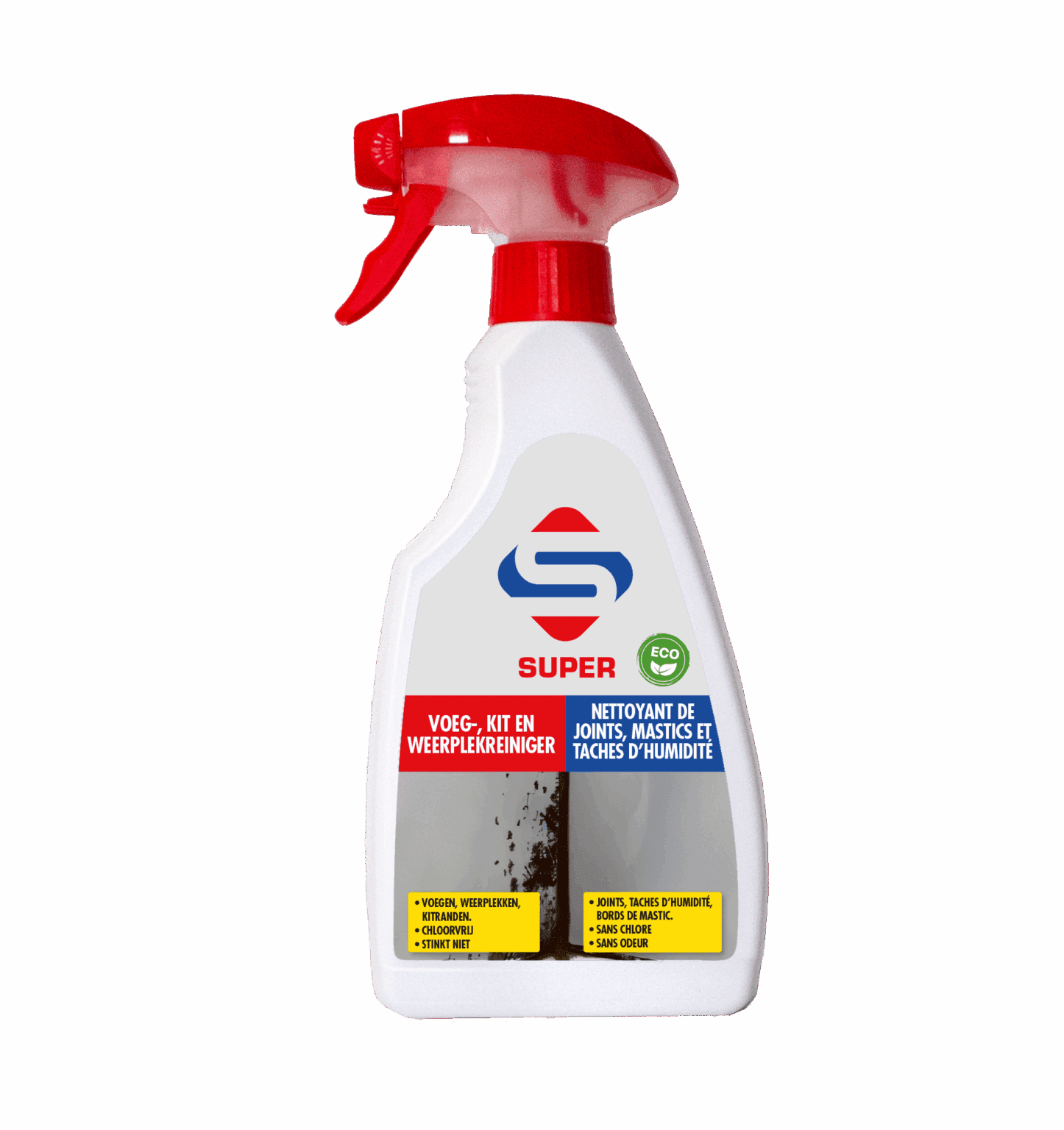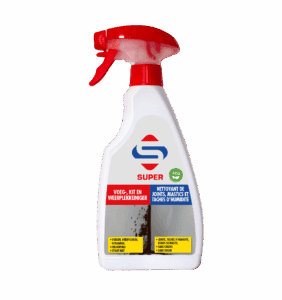Removing limescale in the bathroom is a chore that everyone is familiar with. Hard water leaves small limescale particles on glass, tiles, grouting and taps every day. If you don't tackle this in time, a hard layer will form that is difficult to remove. In this blog, you can read exactly how to remove limescale, which products really work and how to prevent it from returning quickly.
How does limescale form?
Limescale is caused by hard water. This water contains minerals such as calcium and magnesium. When the water evaporates or is heated, these minerals are left behind as a white, hard layer.
You see this mainly in places where hot water is often used: taps, tiles, shower walls, glass doors and toilets. The layer starts as a dull haze and becomes increasingly hard. Ordinary cleaning products can no longer remove it.
It causes dull surfaces, discoloured joints, reduced shine and increased wear. That is why regular descaling is important.
Which resources work and which do not
Many people try to remove limescale using unsuitable products. This happens frequently:
- All-purpose cleaner: this removes dirt, but not limescale.
- Cleaning vinegar: works on light deposits, but not on thick or old limescale.
- Scrubbing: takes a lot of time and damages tiles and glass.
If you want quick results, use a powerful descaler. The best option is a product that sticks to the surface so that it can work slowly.
SUPER Sanitary Descaler & Cleaner
- Unique descaling gel
- Lime scale shower door removal
- Remove lime on tiles
This is how you remove limescale:
The quickest way to remove limescale is to use a powerful descaling gel. Super Sanitary Descaler and Cleaner is just such a gel. Its thick texture means that the product stays exactly where you apply it. This gives the active ingredients time to soak in, quickly loosening limescale, urine scale and light rust.
The gel has been developed for sanitary facilities. This means that it adheres safely to smooth surfaces such as glass, ceramic and chrome. The formula is powerful yet controlled, allowing you to remove limescale without damaging the surface. Thanks to its immediate effect, you will see a difference within seconds.
The Super Sanitary Descaler is designed to quickly loosen thick, old or stubborn limescale. This means you need less product and don't have to scrub for a long time. However, there is one important rule to bear in mind: never use the gel on natural stone, as it can damage calcareous materials.
Below you can read more about removing limescale from different surfaces.
Removing limescale in showers and on tiles
Shower glass calcifies the fastest. The white haze is caused by dried-up droplets. Tiles and grout can also become grey.
How to make your shower sparkle again:
- First degrease shower wall and tiles with Super Degreaser or Super Heavy Cleaner.
- Apply the Super Sanitary Descaler to the surface and allow the product to act for 30 seconds
- Scrub the surface with a Super Scouring Pad or a scouring sponge (scratch-free)
- Rinse off the sanitary cleaner with warm water
For large surfaces, you can apply the gel in strips for an even result.
If you also have discoloured joints or sealant edges, use additional the Super Grout and Weathering Cleaner. This also removes light limescale deposits around edges and joints.
Descaling the tap
Taps lose their shine and develop white deposits around the base and on the spout.
Here's how to do it:
- Dampen/wet the taps with warm water
- Spray the Sanitary Cleaner on the taps
- Leave on briefly
- Use a non-scratch sponge or the super scouring sponge to clean the tap
- Rinse with plenty of water
- If desired, you can buff the taps with a clean (microfibre) cloth
Descaling the toilet
Limescale and urine scale form a hard, yellow-brown layer below the waterline.
Here's how to remove it safely:
- Spray the Sanitary Cleaner under the toilet rim and in the bowl
- Leave this to work for 1 minute.
- Use the toilet brush to clean the toilet bowl under the rim and inside the bowl
- Let it sink in a little longer
- Flushing the toilet
For stubborn deposits, you can repeat the treatment.
Cleaning joints and sealant edges

SUPER Joint & Weathering Cleaner
- Decalcifying joints
- Remove lime on tiles
For joints and sealant edges, use Super Joint and Weather Spot Cleaner. This product contains active chlorine and removes discolouration, deposits and mould spots. Ideal for sanitary areas.
It also works well on light limescale around sealant joints and tile edges.
- Spray the surface to be cleaned
- After spraying, wipe off with water and sponge; in case of heavy soiling, leave on for 2-15 minutes, do not allow to dry completely
- For overhead spray applications, always use safety goggles and avoid inhaling the spray mist
- Ensure adequate ventilation when used in confined spaces (e.g. open window or extractor)
- Can be used safely on steel, stainless steel, ceramics, glass and plastics. Not suitable for cleaning soft metals such as zinc, brass, bronze, galvanised surfaces, among others
Common mistakes when removing limescale
When removing limescale, things often go wrong due to using the wrong products or incorrect methods. These mistakes cause the surface to become dull or damaged more quickly and actually cause the limescale to return more quickly.
- Waiting too long to descale: The longer limescale remains, the harder the layer becomes. You will then need more product and the risk of damage increases.
- Using abrasives that cause scratches: hard scouring pads and abrasives may seem convenient, but they make glass, tiles and taps look dull. Scratches also attract dirt and limescale more easily later on.
- Using acidic agents on natural stone: vinegar, lemon and strong descalers directly attack calcareous stones. The damage is permanent and the surface becomes visibly dull.
- Inadequate rinsing: cleaning residues dry as a haze and later cause streaks or stains. Rinsing with warm water is essential for a satisfactory result.
- Mixing products: descalers and chlorine do not mix well. Mixing these products can produce dangerous vapours. Always use one product at a time and ensure proper ventilation.
Important: Never use an acidic descaling agent on natural stone.
How can you prevent limescale build-up?
With a few simple habits, you can prevent limescale from building up quickly in the bathroom. This means you will need to descale less often and your glass, tiles and taps will stay looking good for longer.
- Wipe dry after every shower: water that remains on the surface will immediately form new limescale stains. The surface can be dried in a few seconds with a squeegee or cloth.
- Wipe down taps and tiles after use: a quick wipe with a microfibre cloth prevents droplets from drying as white deposits.
- Ventilate after showering: good air circulation ensures that moisture evaporates more quickly. Less moisture means less limescale build-up.
- Regular light cleaning: a quick clean prevents limescale from building up. This means you won't need to descale as often.
- Using a water softener: in hard water areas, a softener helps to reduce limescale build-up. This saves a lot of cleaning work and extends the life of your sanitary ware.
Let's get started!
If you want to remove limescale quickly and thoroughly in your bathroom, shower or toilet, Super Sanitary Descaler is the solution for you. The powerful gel works instantly and makes a visible difference.
For discoloured joints and sealant edges, use the Super Joint and Weather Stain Remover as well.
View the sales outlets on our website and choose your supplier. This will enable you to get started right away on a clean and limescale-free bathroom.


